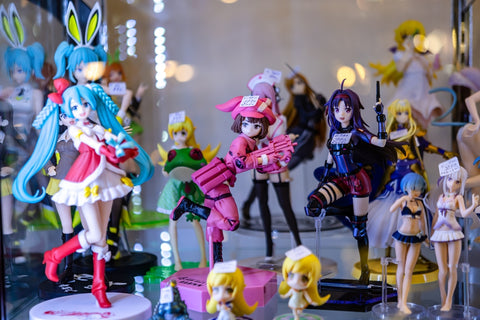Empowerment and Challenges: The State of Being a Woman in Japan Today
The Evolving Role of Women in Japanese Society

In Japan, strides have been made towards gender equality, yet significant challenges persist for Japanese women. While there has been an increase in levels of education and workforce participation among women, traditional gender roles and societal expectations continue to shape their experiences. Japanese women still face obstacles in advancing their careers, achieving work-life balance, and breaking through the glass ceiling in male-dominated industries and leadership positions. Additionally, issues such as the gender pay gap, underrepresentation in politics, and cultural stigmas surrounding motherhood and childcare hinder the full realization of gender equality.
Thus, while progress has been made, there remains a need for continued advocacy and policy reform to create a more equitable and inclusive society for women in Japan.
Historical Perspectives on Femininity in Japan

Traditionally, Japanese women were primarily confined to household chores, expected to fulfill roles as wives, mothers, and caretakers. Women's societal value was often tied to their ability to support and maintain a family. However, the modernization of Japan during the Meiji period (1868-1912) brought about significant shifts in women's roles, creating opportunities for women to participate in the workforce, particularly in factories and textile industries. The post-World War II era in Japan saw the establishment of the 1947 Constitution, which acknowledged women's rights across different spheres such as education, employment, and political engagement. This constitutional framework set the stage for women to pursue higher education and careers beyond traditional domestic roles.
In subsequent decades, Japan experienced rapid economic growth and social change, leading to increased opportunities for women in the workforce.
Navigating the Workplace: Women's Employment in Japan

In Japan, the employment landscape of women has evolved over the years, yet gender issues remain a challenge in the workplace. The gender pay gap persists, with female employees earning less than their male colleagues for comparable work. This gap is partly attributed to gender stereotypes that often lead to working women being relegated to lower-paying positions or facing barriers to career advancement, particularly in male-dominated industries and higher-ranking positions.
Ongoing efforts to enhance workplace equality in Japan include various initiatives focused on fostering gender diversity and inclusion. Among these, the Equal Employment Opportunity Law (EEOL) stands out as a significant legislation enacted in 1986, with the goal of promoting gender equality and preventing discrimination in the workplace. The law mandates that employers cannot discriminate against employees or job seekers based on gender in recruitment, hiring, promotion, compensation, and other employment-related matters. Additionally, it includes provisions aimed at preventing sexual harassment in the workplace.
The Pursuit of Education and Empowerment

Education has long been recognized as a vital tool in empowering women and challenging traditional gender roles in Japan. One significant advancement in challenging gender stereotypes is the growing number of women in higher education. Today, Japanese women outnumber men in universities, which reflects the changing attitudes towards women's education and a growing recognition of the importance of gender diversity in academia. Furthermore, there has also been an increase of female students pursuing studies in specialized fields that were traditionally dominated by men, such as science, technology, engineering, and mathematics. Initiatives aimed at encouraging young women in these fields, along with scholarships and mentorship programs, have helped break down the barriers and create pathways for women to excel in these male-dominated industries.
Wanna learn more about Graduation in Japan? Check our blog post HERE!
Women in Leadership: Breaking the Glass Ceiling

In Japan, the representation of women in leadership positions has long been a topic of discussion, with efforts underway to address the gender disparities and promote greater diversity in various sectors, including politics, business, and community leadership. While progress has been made in recent years, significant barriers remain, hindering women's advancement to top leadership positions.
In the realm of politics, Japan has historically lagged behind other Western nations in terms of female representation. Women continue to be underrepresented in the Japanese Diet despite the initiatives made to support them.
Similarly, in the corporate sector, the "bamboo ceiling", a term used to describe invisible barriers that prevent female workers from advancing to top positions, continues to impede women's career progression. While Japanese companies have made efforts to promote diversity and inclusion, women remain underrepresented in senior managerial positions due to factors like the country's corporate culture that values seniority and hierarchy as well as implicit bias against women in leadership roles.
The same goes with community leadership roles in nonprofit organizations and the Japanese government, where women also encounter barriers to entry and advancement. The traditional role and societal expectation engraved in their gender hinder women from taking on leadership roles despite their contributions to community development and social welfare.
Cultural Expectations of Femininity and Beauty

Cultural norms and media play a significant role in shaping perceptions of femininity and beauty in Japan, influencing societal expectations and individual experiences. Japanese women are expected to conform to the ideal femininity in Japan, which emphasizes qualities such as modesty, humility, and self-sacrifice. Additionally, the concept of "yamato nadeshiko," or the idealized Japanese woman, embodying virtues such as grace, loyalty, and domesticity, further shapes societal expectations of female behavior. Japanese media also plays a role in reinforcing and perpetuating these ideals, often depicting slender, youthful women with flawless skin and delicate features, setting unrealistic standards of beauty for women to aspire to.
Because of the pressures to conform to these societal expectations, many women engage in practices such as skincare routines, dieting, and fashion choices to align with prevailing beauty standards. However, there is a growing number of Japanese women who are challenging these traditional norms by advocating for greater acceptance of diverse body types, appearances, and expressions of gender identity.
The Impact of Popular Culture on Japanese Femininity

The Japanese pop culture, encompassing mediums such as manga, anime, and fashion, plays a significant role in shaping perceptions of femininity. Japanese manga and anime often depict female characters adhering to the traditional image of Japanese women, portraying them as nurturing, passive, and submissive. Additionally, fashion trends in Japan often reflect and perpetuate traditional gender norms, with women expected to embody ideals of beauty, elegance, and innocence. The kawaii (cute) culture, characterized by pastel colors, frilly clothing, and childlike accessories, further reinforces the gendered expectation that women should appear youthful and adorable.
Despite the prevalence of traditional gender roles in popular culture, there are instances where manga, anime, and fashion challenge these norms. Popular manga series like "Sailor Moon" and "Cardcaptor Sakura" showcase heroines who balance their roles as fighters with characteristics deemed traditionally feminine, while "Nana" and "Revolutionary Girl Utena" explore themes of female empowerment, challenging stereotypes and advocating for gender equality. In fashion, there is a growing trend of gender-neutral and gender-fluid styles that blur the lines between masculine and feminine aesthetics, like COMME des GARÇONS and Yohji Yamamoto. Similarly, street fashion movements like Harajuku and Shibuya showcase diverse expressions of identity, providing platforms for Japanese women to subvert conventional beauty standards and embrace self-expression.
Family Life and Societal Expectations

In Japanese society, women face a myriad of expectations regarding marriage, motherhood, and family responsibilities, which can significantly impact their personal and professional lives. Marriage is often viewed as a crucial milestone for women in Japan, with societal expectations dictating that they marry at a relatively young age and prioritize family life over personal ambitions. Single women past their twenties may face social stigma and scrutiny. Additionally, there is pressure for women to marry "up", seeking partners with higher socioeconomic status or educational attainment, which can further limit their choices and autonomy.
Once married, women are expected to fulfill traditional roles as caregivers and homemakers, with motherhood being a central aspect of their identity. Being a good wife meant prioritizing the well-being of their children over their own career aspirations. Beyond motherhood, women are also tasked with managing various family responsibilities, including caregiving for elderly relatives and maintaining familial harmony.
Because of these expectations, many women experience difficulty in pursuing higher education or advancing in their career path due to the demands of family life. Additionally, the lack of support structures, such as affordable childcare and flexible work arrangements, exacerbates the challenges faced by women in balancing work and family obligations.
Advocacy and Activism: The Fight for Gender Equality

Japan has seen the emergence of various movements and organizations dedicated to advancing women's rights and promoting gender equality like:
-
Japan Women's Association (JWA): Founded in 1946, the JWA is one of the oldest and most prominent women's rights organizations in Japan and focuses on a wide range of issues, including gender-based violence, reproductive rights, and workplace discrimination.
-
#KuToo Movement: Inspired by the global #MeToo movement, the #KuToo Movement is a campaign launched in 2019 by Japanese actress and activist Yumi Ishikawa. This movement protests against workplace dress codes that require working women to wear high heels, which can be uncomfortable and harmful to their health.
-
HeForShe Japan: A global solidarity movement led by UN Women that encourages Japanese men to take action against gender-based discrimination and support women's empowerment initiatives in various spheres in society.
These initiatives have played a crucial role in raising awareness, advocating for policy changes, and challenging societal norms that perpetuate gender discrimination.
Celebrating Womanhood: Women’s Day in Japan

In Japan, International Women's Day, is observed on March 8th each year, and is a day to recognize and honor the achievements and contributions of women in various fields. It is celebrated through various events, initiatives, and campaigns aimed at raising awareness about gender equality issues and advocating women's rights. One of the main events of this holiday is Women's March Tokyo, where women and allies come together to advocate for gender equality, human rights, and social justice. One of the key objectives of the Women's March Tokyo is to amplify women's voices and provide a platform to share personal stories and experiences to raise awareness and advocate for meaningful change.
Mental Health and Well-being Among Japanese Women

Japanese women face unique mental health challenges stemming from various sources, including workplace stress and societal expectations. Women, particularly those in demanding industries, suffer from long working hours, intense pressure to succeed, and limited opportunities for advancement, leading to high levels of stress and burnout among female employees. Furthermore, the cultural norm that women should prioritize family and household responsibilities over their needs and aspirations can lead to feelings of guilt and psychological distress.
Despite these challenges, there are resources available that support women's mental health. Mental health awareness campaigns aim to reduce stigma and encourage individuals to seek help when needed, while counseling services and support centers provide avenues for women to receive confidential assistance and connect with others facing similar struggles.
The Role of Women in Japan's Future

As Japan grapples with demographic shifts, changing societal norms, and ongoing efforts to promote gender equality, the role of women in Japanese society is poised to undergo significant transformation in the coming years, which may include the following:
-
Increase Workforce Participation: As Japan faces labor shortages and an aging population, there may be a gradual increase in women's participation, as well as an increase of female leaders in the workforce.
-
Changing Family Dynamics: Shifting attitudes towards marriage and child-rearing are reshaping traditional family structures in Japan. Delayed marriage, declining birthrate, and an increasing number of dual-income households are influencing women's choices and priorities.
International Perspectives: Japan in the Global Gender Equality Context

Japan, while making progress in certain areas, still faces significant challenges in combatting gender issues, especially in the workforce and politics. Compared to countries like Sweden and Iceland, Japan has a lower workforce participation rate for women. This can be attributed to cultural norms, limited access to childcare facilities, and traditional gender roles that prioritize Japanese men as breadwinners. Japan has also been slower to implement measures aimed at closing the persistent gender pay gap in the country, compared to countries like Iceland and Finland who have implemented legislation to address gender pay disparities. Additionally, Japan lags behind Western countries like New Zealand and Canada in terms of female representation in political leadership positions. While these countries have had female heads of state or government, Japan has not yet elected a female prime minister.
Resources and Support for Women in Japan

Although there remain persistent gender issues in Japan, the presence of robust resources, support networks, and organizations dedicated to women's rights, health, and professional development reflect the country's commitment to fostering a more inclusive and equitable society. Organizations like the Japan Women's Innovative Network and the Women's Leadership Initiative offer leadership development programs, mentoring, and networking opportunities for women to enhance their professional skills and advance in their careers. Meanwhile for Japanese women seeking support in areas like discrimination, employment rights and domestic violence prevention, the Japan Federation of Women's Organizations and the Japan Women's Associate provide legal aid and advocacy services. Women's healthcare and wellness are also supported by organizations like the Japan Society of Obstetrics and Gynecology and the Japan Women's Health Association, which focus on promoting women's health education, access to healthcare services, and advocacy for reproductive rights.
As awareness grows and momentum builds in empowering women, there is hope for a future where Japanese people, regardless of gender, can enjoy equal rights and opportunities in the country.
Why not honor the remarkable women in your life with a delightful gift from Bokksu Boutique? Don't miss out on our new Cherry Blossom Collection, inspired by the beauty of spring in Japan, featuring a captivating array of sakura-inspired delights.
Author Bio





























